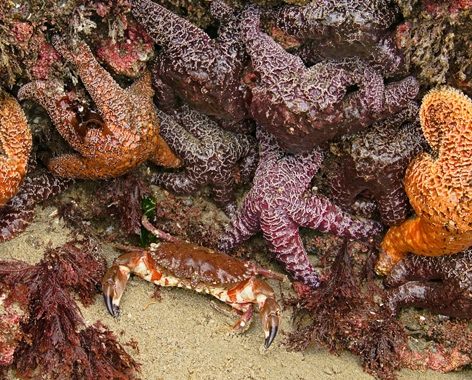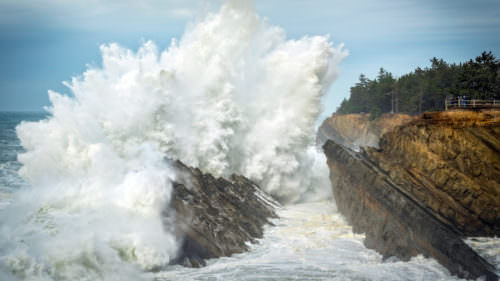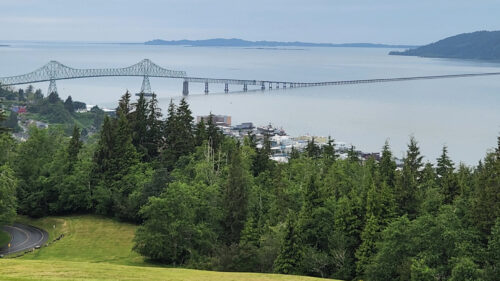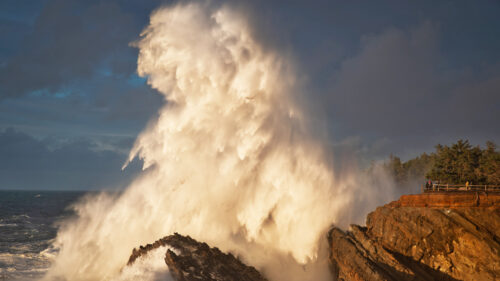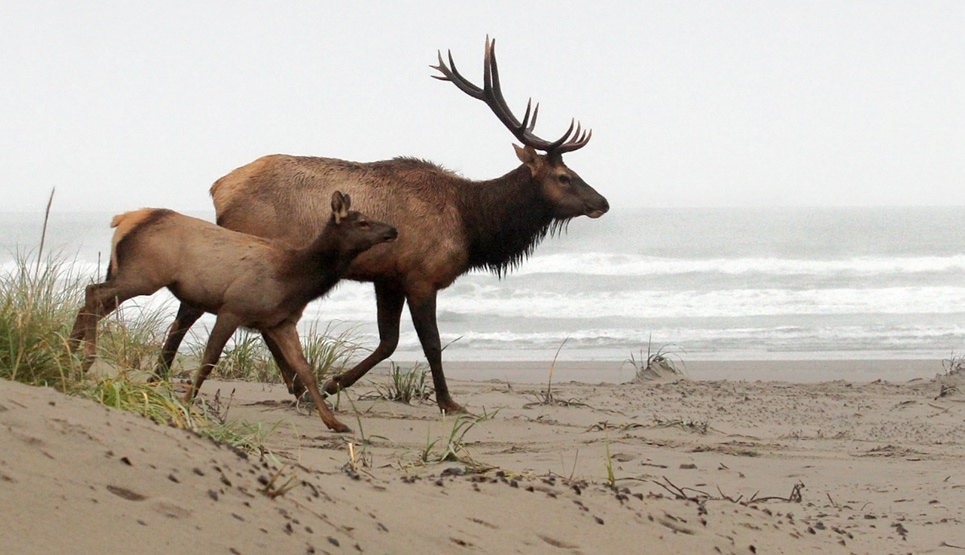
The Oregon Coast winter is motion. Waves, gales, tides, rain smearing glass and draining to bays and creeks and rivers, flushing into the cold Pacific. Gulls surf and swoop in spindrift above big swells, sheer and roiling and loud, bashing ancient rock and sea stacks. It’s a common but always magical sight to behold. Yet gulls are not winter’s only wildlife. This season, which is largely undiscovered for wildlife viewing, head to the Coast for some of the state’s most compelling critters — dozens of species of migratory birds, tidepools teeming with life, thousands of whales and boisterous sea lions.
Not to mention whales — lots of them. You can learn more at Oregon Whale Watch Week (Dec. 28, 2022-Jan. 1, 2023), which returns in-person coastwide this year after a hiatus since 2019. Trained volunteers will be stationed at 17 locations coastwide to help visitors spot thousands of gray whales as they make their winter migration along the Coast. Check out the best spots to watch whales, or head to the newly reopened Whale Watching Center in Depoe Bay for more.
Be a Steward
Remember to be a steward for Oregon’s wildlife by following a few important rules:
- Remember to stay at least 100 yards away, just over the distance of a typical city block, from seals and other marine mammals as you explore the Oregon Coast. Disturbing or harassing marine mammals is not only harmful for the animals, it’s also illegal.
- If you bring trash or food with you to the Coast or any other region, please pack it out with you. Unintentionally left food and garbage on the beach has the potential to attract unwanted predators into Western snowy plover habitats. This threatened species makes their nests along about 45 miles of the state’s beaches; look for these well-marked areas and be sure to keep your distance.
- At tide pool areas, visitors should only walk on bare and dry rocks to avoid crushing or harming coastal creatures. Also be sure to never turn your back on the ocean, never stand on driftwood and always watch for dangerous sneaker waves. Read up for more tips on how to visit the Coast responsibly.
Here are some top wildlife spots to check out this season.
North: Columbia River to Depoe Bay
Fort Stevens State Park
Rife with history and marking the mouth of the mighty Columbia River, this 4,300-acre military monument has no shortage of animals. Among forests, wetlands and dunes are 6 miles of hiking trails. Waterfront viewing platforms allow easy access to all sorts of wintery fauna, including Roosevelt elk, harbor seals, great blue herons, auklets, beavers and bald eagles, plus thousands of migrating shorebirds. Nearest town: Astoria.
Ecola State Park
Crowned by iconic Tillamook Head, these 9 miles of beach, Sitka forest, bluffs and sea stacks present myriad wildlife-spotting opportunities. Vista points, an abandoned lighthouse, wooded headlands and the sandy shore host park wildlife such as Roosevelt elk, deer and raptors. The scenic vantage overlooking Indian Beach (south of Tillamook Head) is nice for spotting gray whales during spring (peaks in March) and winter (peaks in December) migrations. Nearest town: Cannon Beach.
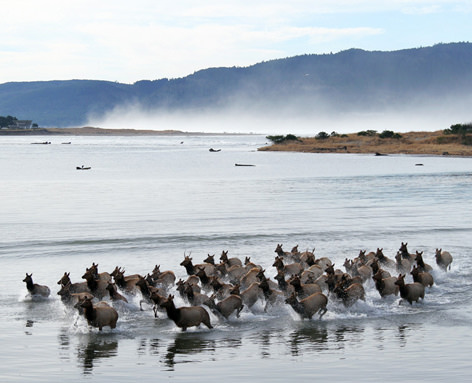
Bayocean Spit, Tillamook Bay
Splitting Tillamook Bay from the Pacific, this diverse spread of sand and flora was once slated to become the West’s version of Atlantic City. Mother Nature intervened, leaving quiet Bayocean Spit to us with its excellent birdwatching opportunities, from sanderlings to scoters at the water’s edge, to terns, osprey and herons in the bay. Nearest town: Tillamook.
Cape Meares State Scenic Viewpoint/Three Arch Rocks National Wildlife Refuge
Old-growth-forested with several viewpoints (including a photogenic lighthouse) perched 200 feet above the sea, this area is highly valuable for watching gray whales (both migrating and resident) as well as humpbacks, orcas and sperm whales during their yearly migrations to/from Alaska. Also fascinating is Oregon’s biggest breeding colony of tufted puffins. Binoculars required. Nearest town: Tillamook.
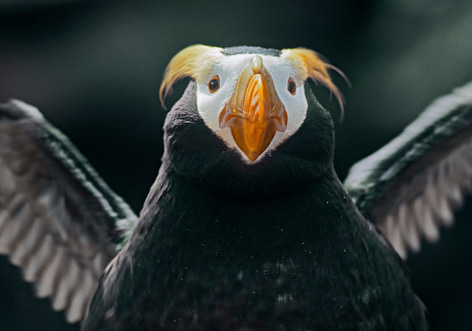
Central: Depoe Bay to Coos Bay
Yaquina Head Outstanding Natural Area
Visit and you’ll quickly agree that “outstanding” is an accurate way to describe this hook-shaped basalt headland poking a mile into the Pacific. Explore its forests, islands and sheltered pocket beaches, all with handy interpretive signs and viewing platforms. Many seabird species and migrating gray whales complement the year-round, harbor-seal refuge just offshore; if tide pooling is your thing, large green anemones, purple urchins and orange sea stars add colorful accents to the barnacle-caked rocks. Nearest town: Newport.
Cape Perpetua Scenic Area
You don’t have to be outdoors to see wildlife — the Cape Perpetua Visitor Center affords stellar views of the Pacific, where gray whales are often seen passing. But once outside, you can choose from several trails, either up the hills or down to the beach. Both offer wildlife watching, from teeming tidepools to enchanting old-growth Sitka forests — from anemones to eagles, if you will, and everything between. The visitor center is open year-round. Nearest town: Yachats.
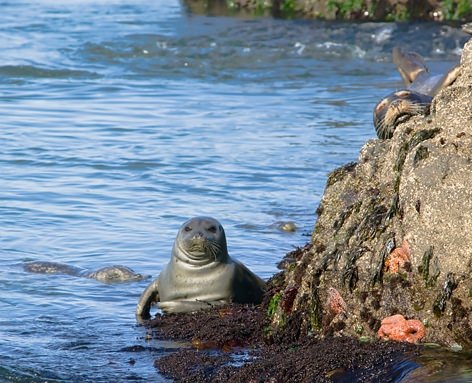
Heceta Head Lighthouse State Scenic Viewpoint
One of the world’s most scenic (and most photographed) lighthouses rests between ocean and forest atop Cape Creek. Here you can see puffins, cormorants, common murres and oystercatchers resting on sea stacks and in cliffside nooks. Whales and sea lions are viewed frequently, as are brown pelicans and bald eagles. At low tide, Cape Cove opens for tidepooling and shorebird spotting. Nearest town: Florence.
Oregon Dunes National Recreation Area, South Jetty Watchable Wildlife Site
Along this vast stretch of dunes and “tree islands” is this special little zone of sandy beach, tidal flats and wetlands that’s particularly good for birding. Shore-dwellers include long-billed curlews, yellowlegs, sandpipers and plovers, while the wetlands typically showcase red-tailed hawks, northern harriers, tundra swans, marsh wrens, yellow-rumped warblers and white-tailed kites. Nearest town: Florence.
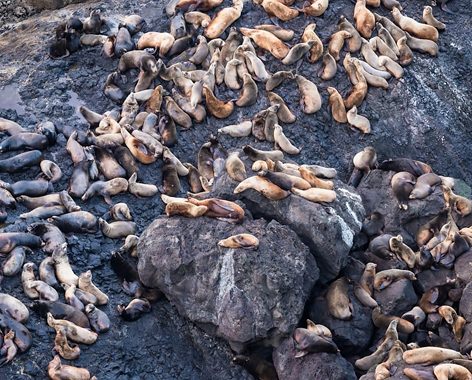
South: Coos Bay to Brookings
Simpson Reef/Shell Island
A rich collection of offshore rocks, reefs and islands serves as breeding/resting sites for a host of life, notably northern elephant seals — the largest of the seal species and the world’s deepest-diving mammal. More common mammals seen here are sea lions (California and Stellar), harbor seals, plus southerly migrating gray whales. Some of our winged friends here include pelagic cormorants, black oystercatchers and osprey. Nearest town: Charleston.
Coquille Point
This headland oversees a stunning collection of rocks, tidepools and sea stacks that is home to thousands of marine mammals and seabirds, the latter majority being common murres. The flat, paved interpretive trail is highly useful. Also present are black oystercatchers, Leach’s storm-petrels, Western gulls, pigeon guillemots, tufted puffins and Brandt’s cormorants. Nearest town: Bandon.
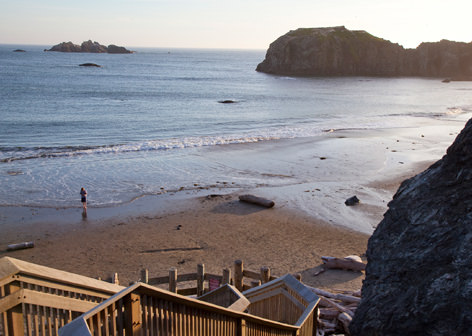
Cape Blanco State Park
The second-westernmost (and likely windiest) point in the lower 48, Cape Blanco lies at the end of a 6-mile road west of Highway 101. Its eponymous 1,880-acre park is home to a variety of wildlife, from tidepools to tundra, sea stacks to Sitka. Near the water, you may see scoters, grebes, loons and marbled murrelets. In the fields, you might find bluebirds and raptors such as harriers and kites. In the ocean, you could see breaching gray whales and an abundance of pinnipeds. Just don’t forget your windbreaker. Nearest town: Port Orford.
Harris Beach State Park
Facing Oregon’s biggest island (Bird Island, aka Goat Island), Harris hosts a National Wildlife Sanctuary, a nesting site for tufted puffins, Leach’s storm-petrels and many other seabirds. The cliffs above the beach are prime spots for viewing gray whales. The beach itself is chockablock with rocks and tidepools and shifting sands. In the forests above, you’ll find deer, quail, rabbits and all sorts of raptors. Nearest town: Brookings.
